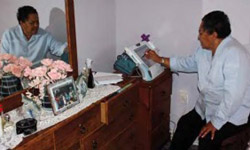Cutting edge care in the 'wop wops' - rural Bay of Plenty

May 2015
Kiri Henry lives deep in the heart of Tuhoe country – surrounded by verdant hills and bird song, but with not a neighbour in sight.
Welcome to the wop wops,’ she greets us, a warm smile on her face.
It is a magnificent location, pure New Zealand countryside, the best kind. But it’s also a long way off the beaten track, which can be dangerous if you have lung disease and heart problems.
Seven times in the past year the rural solitude has been split by an ambulance siren as Kiri was rushed to the hospital.
She now has a sophisticated way to carefully track her own health – despite her physical distance from the nearest hospital. Those results are also beamed back to the watchful eyes of her case manager – a registered nurse at Te Whiringa Ora – a service which develops individual care plans for people with chronic illnesses.
It was through the trusting relationship the case manager built with Kiri that she was willing to try out a special computerised device which would help her to better self-manage her health. A telehealth monitor was installed in her home allowing her to measure her pulse, blood pressure, lung capacity, lung function, electrical activity in her heart and other health indicators.
Kiri takes a series of measurements each day, in the comfort of her own bedroom. Within weeks of starting to use this ‘telehealth’ device, her case manager had used its data to book a visit for Kiri from a respiratory nurse, a referral to her GP, a meeting with a district nurse and a respiratory nurse, and a session with a podiatrist.
The aim is to help Kiri get treatment before things get to the point where hospitalisation is required. ‘The caring they’ve committed to me has been a real blessing to me,’ Kiri says.
A sophisticated medical device, not much bigger than a fax machine, has enabled Kiri to more effectively manage her own health.
This case study was originally published in the Better, Sooner, More Convenient Health Care in the Community ebooklet (on the Ministry of Health website).
